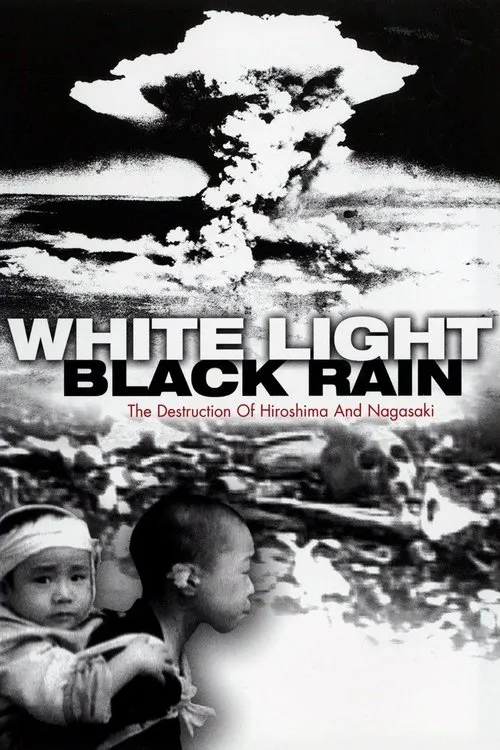White Light/Black Rain: The Destruction of Hiroshima and Nagasaki

Plot
In the documentary film "White Light/Black Rain: The Destruction of Hiroshima and Nagasaki," Steven Okazaki crafts a poignant and introspective exploration of one of the darkest chapters in human history. The film delves into the devastating consequences of the atomic bombings in Hiroshima and Nagasaki during World War II, shedding light on the enduring pain and trauma experienced by survivors of these cataclysmic events. The documentary begins with a haunting introduction, as Okazaki sets the stage for the tragic events that unfold. Through a montage of archival footage and eyewitness accounts, the film vividly conveys the shock and horror of the bombings. On August 6, 1945, a B-29 bomber dropped an atomic bomb, code-named "Little Boy," on Hiroshima, releasing an unfathomable amount of energy that razed the city in a matter of seconds. Just three days later, a second bomb, "Fat Man," was dropped on Nagasaki, leaving an equally devastating trail of destruction and loss. Okazaki's primary focus, however, lies not with the bombings themselves, but with the human cost. Through intimate interviews with fourteen survivors of the atomic blasts – hibakusha, in Japanese – the film sheds light on the lives of ordinary people caught in the midst of chaos. Many of these survivors, known as "hibakusha," had never spoken publicly about their experiences before Okazaki's cameras captured their stories. Their voices – raw, honest, and heart-wrenching – provide a unique perspective on the events that transpired. One of the most striking aspects of "White Light/Black Rain" is the way Okazaki juxtaposes the testimonies of Japanese survivors with those of four Americans intimately involved in the bombings: Tibor Kiskala, a Hungarian-born B-29 gunner; James Yamada, a Nisei-American interpreter; Paul Fussell, a former US Army officer; and Tsutomu Katayama, a Japanese-American who was in the midst of serving in the US Army Air Forces. The inclusion of these diverse perspectives serves to underscore the complexities and nuances of the bombings, moving the narrative beyond a simple victim-perpetrator dichotomy. These interviews form the emotional heart of the film, allowing viewers to connect with the individuals behind the statistics and headlines. One hibakusha, named Yoko Matsumoto, shares her account of being in the midst of Hiroshima's destruction, forced to watch in horror as buildings and trees vanished into a blinding flash. Her narrative is a masterclass in restraint, conveying the depth of her trauma without ever resorting to melodrama. Conversely, Tibor Kiskala's experiences reveal the more nuanced aspects of the bombings, exposing the conflicting moralities at play in the midst of war. Through these personal stories, "White Light/Black Rain" humanizes the victims of the atomic bombings, challenging the viewer to confront the moral implications of these events. Okazaki's approach is neither preachy nor didactic, instead allowing the hibakusha and their stories to speak for themselves. The film's most poignant moments arise from these quiet, introspective testimonies, rather than any grand pronouncements. In addition to the personal stories, the documentary also delves into the physical aftermath of the bombings. Stunning archival footage and photographs illustrate the unimaginable scale of destruction, as well as the eerie silence that followed the blasts. Okazaki's meticulous research and attention to detail bring to life the scientific aspects of the atomic bombings, offering a clear explanation of the devastating effects of radiation on human tissue. As the film progresses, Okazaki raises crucial questions about the legacy of the atomic bombings and their relevance to the present day. The documentary suggests that the consequences of the bombings have been largely forgotten or swept under the rug, relegated to a distant footnote in the annals of history. Okazaki counters this narrative by emphasizing that the pain experienced by hibakusha in Hiroshima and Nagasaki remains raw and relevant, serving as a stark warning about the perils of nuclear proliferation. Ultimately, "White Light/Black Rain" emerges as a powerful indictment of the destructive power of nuclear warfare, but also as a testament to the resilience and courage of the human spirit. Okazaki's masterful direction creates a film that is at once a memorial to the victims of the atomic bombings and a clarion call to action, urging viewers to confront the dangers of nuclear proliferation and work towards a world free from the threat of these devastating weapons. Through the stories of hibakusha and their interactions with Americans involved in the bombings, "White Light/Black Rain" forges a powerful bond between cultures and generations. In doing so, Okazaki affirms the power of documentary filmmaking to educate, to inspire, and to challenge our perceptions of the past. This film will undoubtedly leave viewers grappling with the magnitude of the atomic bombings, while also illuminating the urgent need for a nuclear-free world.
Reviews
Recommendations




